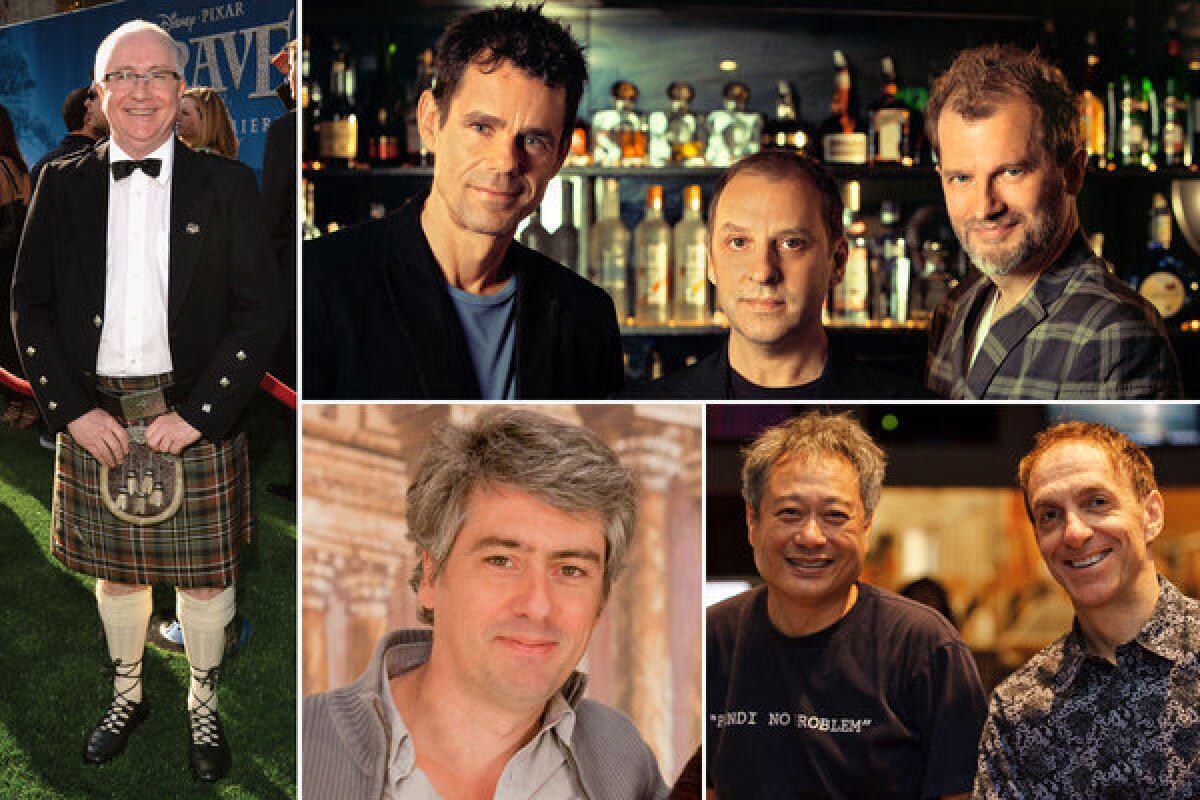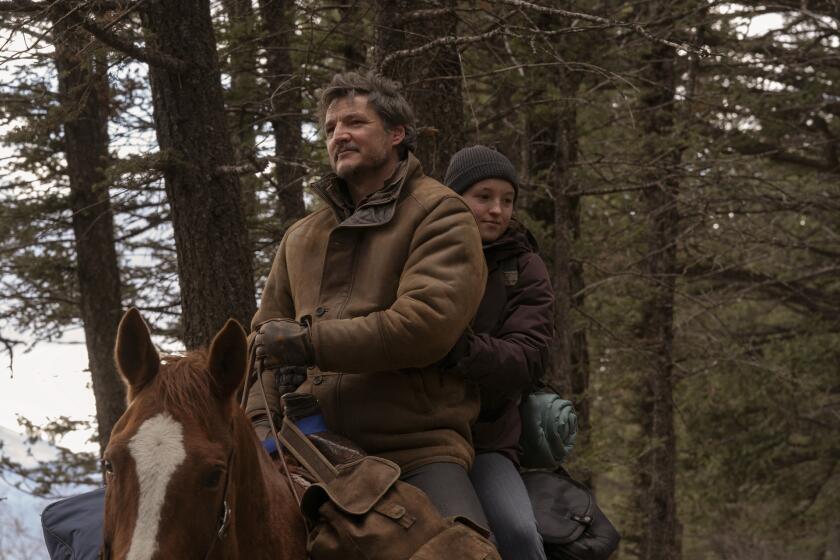For film scores, composers create a world, note by note

- Share via
A film’s music is often considered a character itself, and this season the roles composers have to play aren’t getting any easier. Talking about love between the emotionally unstable is one thing, but how, for instance, does that sound? Or when a character speaks to God, should God answer back with silence or an orchestra? And what of a period piece that isn’t a period piece, or a piece that’s six periods at once? Here we offer a look at just a handful of 2012’s notable film scores.
Mychael Danna
It was early September, and Mychael Danna was nearing the end of his eight months of work on “Life of Pi,” the composer’s third collaboration with director Ang Lee. The 80-piece orchestra assembled at the 20th Century Fox lot was on a break, and Danna, in a rare quiet moment in the studio’s harp room, was asked to reflect on his initial conversations with Lee about the film.
“I was scared,” said Danna. The composer had reason to be nervous. Lee was essentially asking him to create a sound that could stand in for God. “Only a daredevil would attempt to do this,” Danna said.
And yet here he was, trying to find a way to accompany a film about a man’s test of faith on a boat in the middle of the ocean with a Bengal tiger. Just to further complicate matters, “Life of Pi” would start in India, bring in elements of numerous major religions and use music where most films would use dialogue.
The director laid out what he wanted Danna to accomplish. “We want the audience to be in awe to the unknown, but at the same time we want it to be emotional,” said Lee, joining in the conversation. “Those ideas are opposing each other … and we knew we were going to use a lot of music because there’s no dialogue for the higher power.”
Danna’s score emphasizes warmth and subtlety. The film opens with the symphonic hug that is “Pi’s Lullaby,” written and composed with Bombay Jayashri, and goes on to embrace Indian and island rhythms, colorfully upbeat French horns, and English and Tibetan choirs. The music is rich and full of life, at least until Pi Patel’s life is thrown into havoc and he’s set adrift on the ocean.
Danna hoped to use an assortment of multicultural influences to create a score that felt universal.
“The questions Pi asks and what he goes through — the crisis of faith — those are things everyone experiences,” Danna said. “If you get too specific, you cut off a great piece of humanity. The score had to feel non-specific and worldly in a non-world music way.”
Johnny Klimek, Reinhold Heil and Tom Tykwer
With its six subtly interconnected stories spanning centuries and locations, the David Mitchell book that inspired “Cloud Atlas” presented numerous challenges for filmmakers Tom Tykwer and the Wachowski siblings. But the composers didn’t have it easy either.
Music plays a large role in Mitchell’s book, and the author had lofty ambitions for how parts of the story should sound. One of the film’s stories surrounds the “Cloud Atlas Sextet,” a musical creation essentially, described as one of the greatest works of music ever composed.
“How do you write the most memorable piece of music ever? That was the most daunting challenge,” said Johnny Klimek, who composed the score with Reinhold Heil and the film’s co-director Tykwer.
Ultimately, the trio sought inspiration in the works of Claude Debussy and William Schuman, and crafted a piece that was romantically versatile and capable of a swoon-inducing slow-dance.
“It’s described [in the book] as a more avant-garde chamber piece from the 1930s,” Heil said. “On the other hand, it’s said to live on to become a piece that becomes ubiquitous … because it has an ethereal beauty to it. We actually attempted to do that, and at some point we realized it wasn’t going to happen and just tried to write a beautiful piece.”
It’s heard numerous times throughout “Cloud Atlas,” although one must listen carefully to catch each of its genre interpretations. Yet Klimek and Heil, who regularly compose with Tykwer, are used to doing alternative takes.
Before Tykwer even begins filming, the three compose an orchestral score that’s ultimately torn up, remixed and reconfigured. They essentially create their own temporary music and then bring back the orchestra when filming has completed. The end result in “Cloud Atlas” is alternately symphonic and electronic.
“This goes from slapstick comedy to sci-fi, and we realized early on that the music is going to have to hold this together,” Heil said. “There can be no rules and no periods.”
Dario Marianelli
It was nearly a given that the music in a cinematic interpretation of “Anna Karenina” would be ornate. Pivotal plot points — namely romantic intentions — are revealed via dance in the Tolstoy classic. Unexpected, however, was just how much director Joe Wright’s reading of the text would rely on rhythm.
Office clerks move in time to a symphonic beat, and set changes — all of which unfold in a single theater — are guided by an orchestra, as characters step in and out of view as if guided by song. Composer Dario Marianelli, who worked with Wright on period pieces such as “Atonement” and “Pride & Prejudice,” said he didn’t view “Anna Karenina” as a romantic drama.
WATCH: Directors on the future of animation
“There was a lot more dancing here than in the average film, but there’s a lot of rhythm in the pieces you don’t see dancing in,” Marianelli said. “A lot of the movie was conceived like a ballet. Even when you don’t see dancers, there’s a certain aesthetic that comes from ballet and opera. The guiding point for me was to think of this like a ballet.”
That was key, said Marianelli, as six or seven pieces of the film’s score were written prior to the start of shooting. Some scenes, of course, like the two major waltzes, needed to be choreographed. For others, Wright simply wanted to shoot to the score and not the other way around. An overture would eventually tie the varying strains together.
The unconventional approach ensured that Marianelli strayed from any period piece conventions. Though “Anna Karenina” flirts with Russian folk music, polka and French theatricality, it rarely sounds born of the late 1800s.
“We wanted to create a universe that was self-contained, that was self-coherent,” Marianelli said. “That meant not talking waltzes and mazurkas from the repertoire but creating them in a way that could somehow be used as main themes in the film. I tried very carefully to write themes and music that was able to be manipulated and could ultimately generate variations on the theme.”
Patrick Doyle
Five minutes into a conversation with “Brave” composer Patrick Doyle and the topic shifts to fairy tales. No, not the kind recently favored by Disney/Pixar. Doyle is talking more about ancient stories, ones with Scottish giants turned to stone.
There are references in “Brave” to such Scottish folklore — the fable-inspiring Callanish Stones among them — and Doyle hoped his score would evoke these tales of yore. He even speaks of the music in “Brave” as if he’s telling stories around a campfire.
He uses the phrase “Loch Ness of it all” to describe the more rumbling, mysterious aspects of the film’s music, and in speaking of the score’s emphasis on small sounds, such as Celtic harps and violins, he says he wanted to capture the feel of “ancient vials.”
“I had to revisit and rekindle what’s in my blood,” said Doyle, who lives in London but was raised in Scotland. “They said they wanted this to be as Scottish as it could be.”
That wasn’t as simple as adding bagpipes to the standard-issue film orchestra. Bagpipes are perhaps most evocative of Scotland and Ireland, but Doyle wanted to play them like the “medieval equivalent of trumpets.” Also, “Brave,” being a Disney/Pixar film, wouldn’t exactly be a period piece.
To capture the look of the more magical aspects of the film — a pan into a dark, witch-infested forest, for instance — Doyle, who was nominated for 1996’s “Hamlet” and 1995’s “Sense and Sensibility,” turned to computers. The more synthesized moments allowed the strings to startle and the bagpipes to feel all the more lively.
Still more difficult, said Doyle, were the moments that called for vocals. Doyle wanted “Noble Maiden Fair” to sound like a forgotten Scottish lament.
“The simple things in life are the most difficult to create,” he said. “When you think of the most simple melody — ‘Twinkle, Twinkle, Little Star’ — that’s simple. Everyone knows that. Well, you try and write that.”
MORE COVERAGE
PHOTOS: Memorable red carpet moments
VIDEO: Highlights from the Envelope Screening Series
THE ENVELOPE: Awards insider
More to Read
From the Oscars to the Emmys.
Get the Envelope newsletter for exclusive awards season coverage, behind-the-scenes stories from the Envelope podcast and columnist Glenn Whipp’s must-read analysis.
You may occasionally receive promotional content from the Los Angeles Times.











